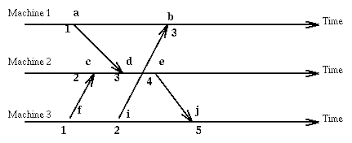For the last couple days, I’ve been watching the distributed systems video lectures and reading the recommended papers that cover logical clocks. Even after making multiple passes on the material, the concepts just haven’t clicked: I cannot wrap my mind around why Lamport’s clocks satisfy only consistency — not strong consistency. But now I think I have a handle on it after sketching a few of my own process diagrams (below).
Before jumping into the examples, let’s first define strong consistency. We can categorize a system as strongly consistent if and only if, we can compare any two related event’s timestamps — and only the timestamps — and conclude that the two events are causally related. In other words, can we say “event A caused event B” just by inspecting their timestamps. In short, the timestamps must carry enough information to determine causality.
Example: Time Diagram of Distributed Execution
In my example below, I’ve limited the diagram to two process: P1 and P2.
P1 executes three of its own events (i.e. event 1, event 2, event 3) and receives an event (i.e. event 4) from P2. P2 executes 2 events (i.e. event 1, event 2), sends a message (i.e. event 3) to P1, then P4 executes a fourth and final event. To show the sending of a message, I’ve drawn an error connecting the two events, (P2, 3) to (P1, 4).

Cool. This diagram makes sense. It’s obvious from the arrow that (P2, 3) caused (P1, 4). But for the purposes of understanding why Lamport’s clocks are not strongly consistently, let’s remove the arrow from the diagram and see if we can reach the same conclusion of causality by inspecting only the timestamps.

Next, let’s turn our attention to the timestamps themselves.

Just by comparing only the timestamps, what can we determine?
We can say that the event with the lower timestamp happened before the event with the higher timestamp. But that’s it: we cannot make any guarantees that event 3 caused event 4. So the timestamps in themselves do not carry sufficient information to determine causality.
If Lamport’s scalar clocks do not determine causality, what can we use instead? Vector clocks! I’ll cover these types of clocks in a separate, future blog post.
